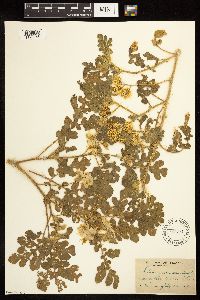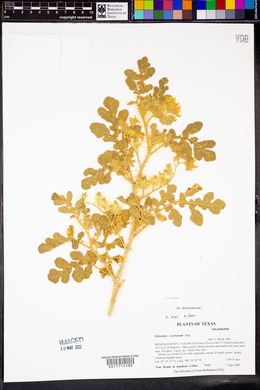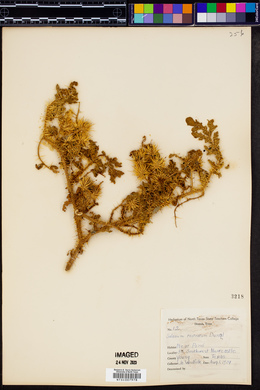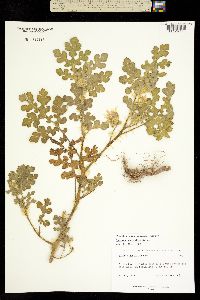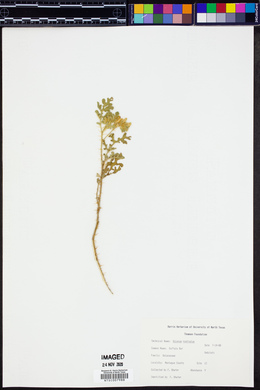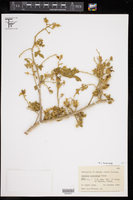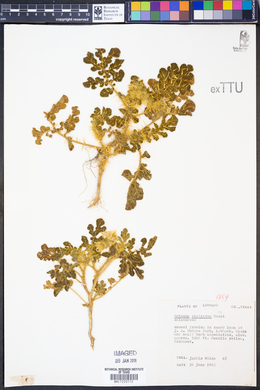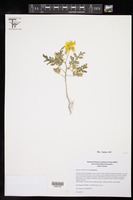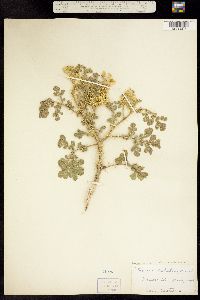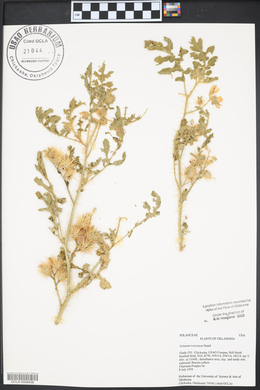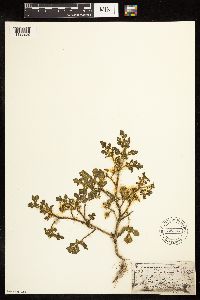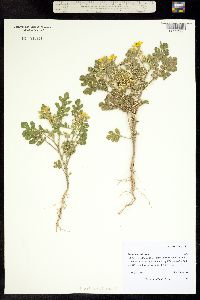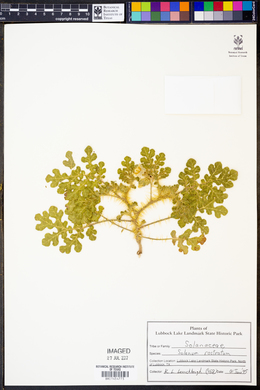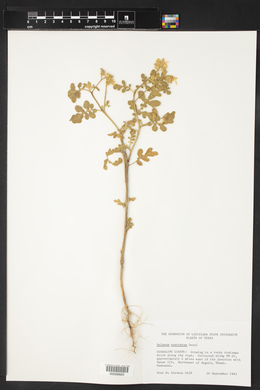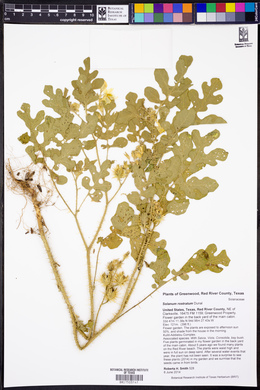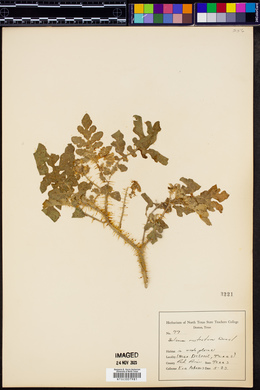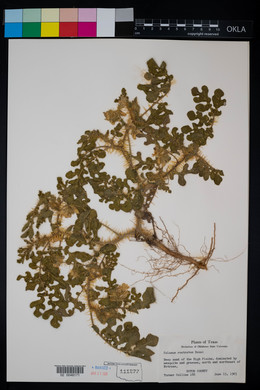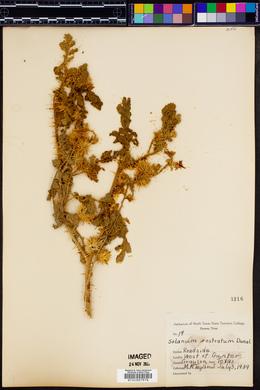Solanum rostratum
|
|
|
|
Family: Solanaceae
Horned Nightshade, more...buffalobur, buffalobur nightshade, Colorado bur, Kansas thistle, Mexican thistle, Texas thistle
[Androcera rostrata (Dunal) Rydb., moreSolanum cornutum auct. non Lam., Solanum propinquum] |
PLANT: Annual herbs, to 70 cm tall, without tubers or stolons, abundantly armed on herbage and calyx with straight, straw-colored prickles, these sometimes more than 1 cm long on fruiting calyces; copiously stellate-pubescent throughout (also with occasional simple hairs), the cauline stellae sessile or sometimes on a stalk up to 1 mm long. LEAVES: alternate, (bi-)pinnatifid to pinnatisect near the base, the lobes irregular in shape with rounded or obtuse apices; blades elliptic to broadly ovate in outline, to ca. 12 cm long, submembranous to subcoriaceous, stellate-pubescent on both surfaces, prickly along principal veins, the veins impressed above; petioles to ca. 8 cm long, usually ca. 2/3 the length of the blade. I INFLORESCENCE: raceme-like monochasial cymes, to ca. 15 cm long; peduncles 1-4 cm long. FLOWERS: somewhat zygomorphic (Fig. 3D); pedicel to ca. 1 cm long; calyx 5-12 mm long, the lobes usually at least 2 times as long as the tube (sometimes much longer); corolla rotate, yellow, 15-25 mm in diam., stellate-pubescent on the outer surface, loosely folded between the lobes, the two lower lobes somewhat larger and curving outward; stamens unequal; anthers ca. 2 times longer than filaments, the lowermost anther greater than 1 cm long, red-purple tinged, curved, the 4 uppermost anthers 6-8 mm long, yellow, straight; style curved, equal to or exceeding the long anther. FRUITS: 9-12 mm in diam., erect, closely invested by the densely prickly, accrescent tube of the calyx; seeds flattened, ovoid, dark brown, alveolate. NOTES: A common weed of overgrazed pastures and roadsides: all cos. except La Paz, Yuma (Fig. 2F); 250-2250 m (800-7400 ft); Jun-Sep; all states except FL; throughout Mex. and s Can. REFERENCES: Chiang, F. and L.R. Landrum. Vascular Plants of Arizona: Solanaceae Part Three: Lycium. CANOTIA 5 (1): 17-26, 2009. Bates et al. 2009, Kearney and Peebles 1969, McDougal 1973 Duration: Annual Nativity: Native Lifeform: Forb/Herb General: Stout, herbaceous annuals, to 80 cm tall, stems branching, herbage and calyx heavily armed with yellow spines 3-12 mm long, herbage not glandular but densely stellate-pubescent and puberulent, plants without tubers or stolons. Leaves: Alternate, leaf blades elliptic to broadly ovate in outline, to 12 cm long and 5 cm wide, irregularly pinnately lobed or twice pinnatifid to pinnatisect near the base, somewhat membranaceous and leathery, stellate-pubescent on both surfaces, prickly along principal veins, the veins impressed above, borne on stout petioles 1-5 cm long. Flowers: Yellow, corollas rotate, (somewhat zygomorphic) with 5 angles or lobes, 1.5-3 cm in diameter, loosely folded between the lobes, the two lower lobes somewhat larger and curving outward, stellate-pubescent on the outer surface, calyx armed, rotate to campanulate, 5-parted, 5-12 mm long, the lobes usually at least 2 times as long as the tube (sometimes much longer), growing larger with age and closely investing the fruit, stamens 5, inserted on the corolla tube, anthers yellow, the 4 uppermost 5-6 mm long and straight, the lower-most tinged reddish-purple and greater than 1 cm long (about twice as long as the others), curved in the distal third, filaments short, style curved, equal to or exceeding the long anther, flowers borne in monochasial cymes (a cyme having a single flower on each axis) to 15 cm long. Fruits: Globose berry, brown, glabrous, and smooth, 9-12 mm in diameter, closely enclosing the densely prickly calyx. Seeds flattened, ovoid, dark brown, with a honeycombed surface (alveolate), to 3 mm long. Ecology: Found on plains, commonly on overgrazed pastures and roadsides, from 1,000-7,500 ft (305-2286 m); flowering June-September. Distribution: Found in Canada and in all states of the United States except Florida; south to Mexico. Notes: Distinguished by its weedy, annual habit, the yellow flowers, and the dense, sharp prickles all over the plant; and pubescent to puberulent (but not glandular) herbage. Synonyms: Androcera rostrata, Solanum cornutum Editor: LCrumbacher 2011, FSCoburn 2015 Etymology: Solanum is Latin for "quieting," in reference to the narcotic properties of some species, while rostratum means "a bill, snout or beak.- Coarse branching annual 3-10 dm, stellate-hairy throughout, the stems, cals, and to a lesser extent the lvs also beset with yellow spines 3-12 mm; lvs ovate or oblong in outline, deeply pinnately lobed, or the segments again lobed in larger lvs; racemes short-pedunculate, 3-15- fld, condensed at first, elongating to as much as 15 cm; fls light yellow, 2-3 cm wide; 4 anthers alike, yellow, the fifth much longer, curved, often purplish; cal accrescent and enclosing the berry; 2n=24. Dry prairies and plains; native to the Great Plains, now occasionally intr. throughout much of our range, especially westward. Gleason, Henry A. & Cronquist, Arthur J. 1991. Manual of vascular plants of northeastern United States and adjacent Canada. lxxv + 910 pp. ©The New York Botanical Garden. All rights reserved. Used by permission. From Flora of Indiana (1940) by Charles C. Deam This species has been reported from 11 counties but none of the authors state its abundance or whether it persisted. I have found it in 6 counties, and in 3 counties I found only a single plant; in two counties it covered large barnyards; in St. Joseph County, however, it was an abundant and common weed in sandy soil over 2-3 acres in a large barnyard and an adjoining truck garden. The owner despaired of ever being able to eradicate it. It has been collected by Bechtel in Montgomery County where it is established. Miss Edna Banta informs me that it is a weed on a farm near Brooksburg, Jefferson County. No doubt this species can safely be regarded as a permanent introduction. …… Indiana Coefficient of Conservatism: C = null, non-native Wetland Indicator Status: N/A |
|
|
|































